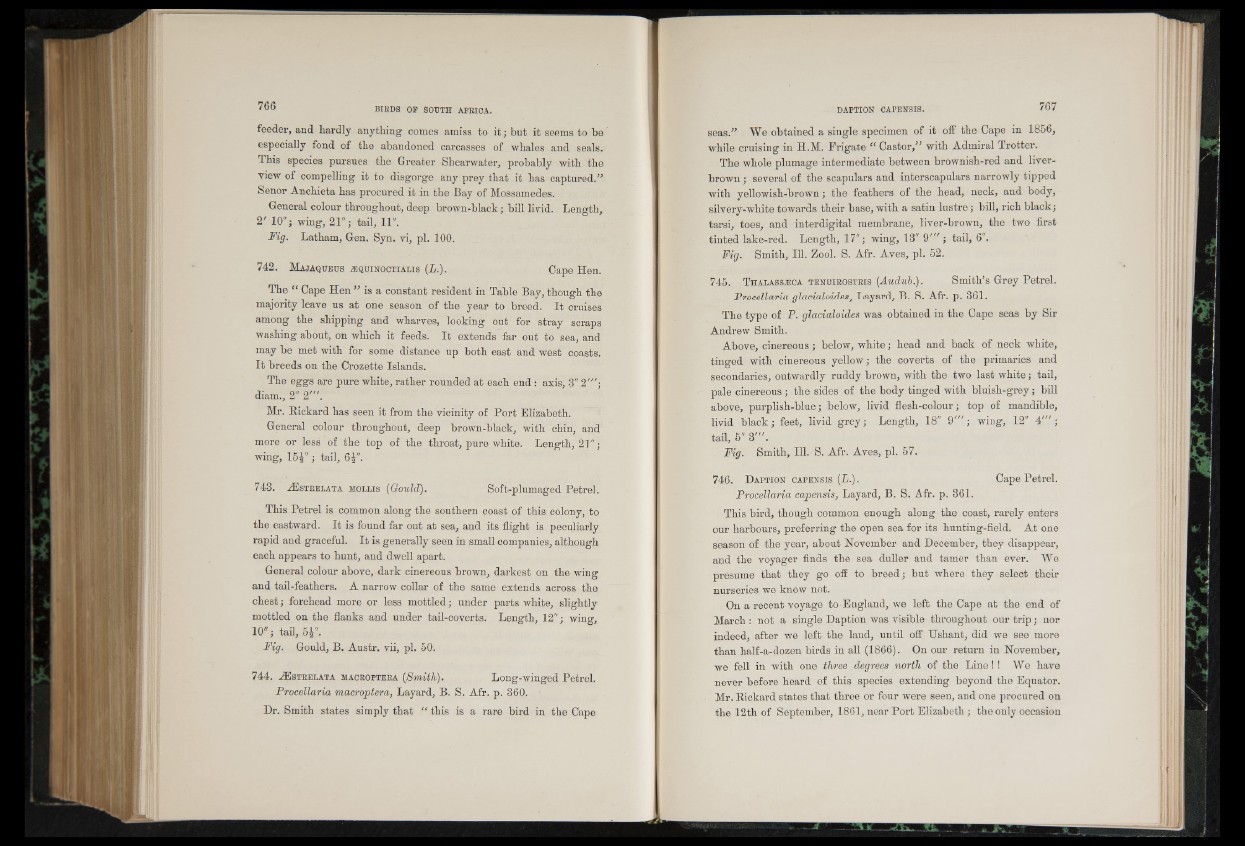
feeder, and hardly anything comes amiss to it; but it seems to he
especially fond of the abandoned carcasses of whales and seals.
This species pursues the Greater Shearwater, probably with the
view of compelling it to disgorge any prey that it has captured.”
Senor Anchieta has procured it in the Bay of Mossamedes.
General colour throughout, deep brown-black; bill livid. Length,
2' 10"; wing, 21"; tail, 11".
Fig. Latham, Gen. Syn. vi, pi. 100.
742. M a j a q u e d s .m q u in o c t i a l i s [L . ) . Cape Hen.
The “ Cape Hen ” is a constant resident in Table Bay, though the
majority leave us at one season of the year to breed. It cruises
among the shipping and wharves, looking out for stray scraps
washing about, on which it feeds. It extends far out to sea, and
may be met with for some distance up both east and west coasts.
It breeds on the Crozette Islands.
The eggs are pure white, rather rounded at each end: axis, 3" 2"';
diam., 2" 2,',.
Mr. Rickard has seen it from the vicinity of Port Elizabeth.
General colour throughout, deep brown-black, with chin, and
more or less of the top of the throat, pure white. Length, 21";
wing, 15J" ; tail,
743. aE strelata mollis [Gould). Soft-plumaged Petrel.
This Petrel is common along the southern coast of this colony, to
the eastward. It is found far out at sea, and its flight is peculiarly
rapid and graceful. It is generally seen in small companies, although
each appears to hunt, and dwell apart.
General colour above, dark cinereous brown, darkest on the wing
and tail-feathers. A narrow collar of the same extends across the
chest; forehead more or less mottled; under parts white, slightly
mottled on the flanks and under tail-coverts. Length, 12"; wing,
10"; tail, h\".
Fig. Gould, B. Austr. vii, pi. 50.
744. .¿Est e e la ta macroftera [Smith). Long-winged Petrel.
Procellaria macroptera, Layard, B. S. Afr. p. 360.
Dr. Smith states simply that “ this is a rare bird in the Cape
seas.” We obtained a single specimen of it off the Cape in 1856,
while cruising in H.M. Frigate “ Castor,” with Admiral Trotter.
The whole plumage intermediate between brownish-red and liver-
brown ; several of the scapulars and interscapulars narrowly tipped
with yellowish-brown; the feathers of the head, neck, and body,
silvery-white towards their base, with a satin lustre; bill, rich black;
tarsi, toes, and interdigital membrane, liver-brown, the two first
tinted lake-red. Length, 17"; wing, 13" 9” '; tail, 6".
Fig. Smith, 111. Zool. S. Afr. Aves, pi. 52.
745. T halassjsca t en u ir o st r is [Audub.). Smith’s Grey Petrel.
Procellaria glacialoides, Layard, B. S. Afr. p. 361.
The type of P. glacialoides was obtained in the Cape seas by Sir
Andrew Smith.
Above, cinereous; below, white; head and back of neck white,
tinged with cinereous yellow; the coverts of the primaries and
secondaries, outwardly ruddy brown, with the two last white; tail,
pale cinereous; the sides of the body tinged with bluish-grey; bill
above, purplish-blue; below, livid flesh-colour; top of mandible,
livid black; feet, livid grey; Length, 18" 9'"; wing, 12" 4 '" ;
tail, 5" 3'".
Fig. Smith, 111. S. Afr. Aves, pi. 57.
746. D a pt io n capensis [L.). Cape Petrel.
Procellaria capensis, Layard, B. S. Afr. p. 361.
This bird, though common enough along the coast, rarely enters
our harbours, preferring the open sea for its hunting-field. At one
season of the year, about November and December, they disappear,
and the voyager finds the sea duller and tamer than ever. We
presume that they go off to breed; but where they select their
nurseries we know not.
On a recent voyage to England, we left the Cape at the end of
March : not a single Daption was visible throughout our trip; nor
indeed, after we left the land, until off Hshant, did we see more
limn half-a-dozen birds in all (1866). On our return in November,
we fell in with one three degrees north of the Line! ! We have
never before heard of this species extending beyond the Equator.
Mr. Rickard states that three or four were seen, and one procured on
the 12th of September, 1861, near Port Elizabeth; the only occasion